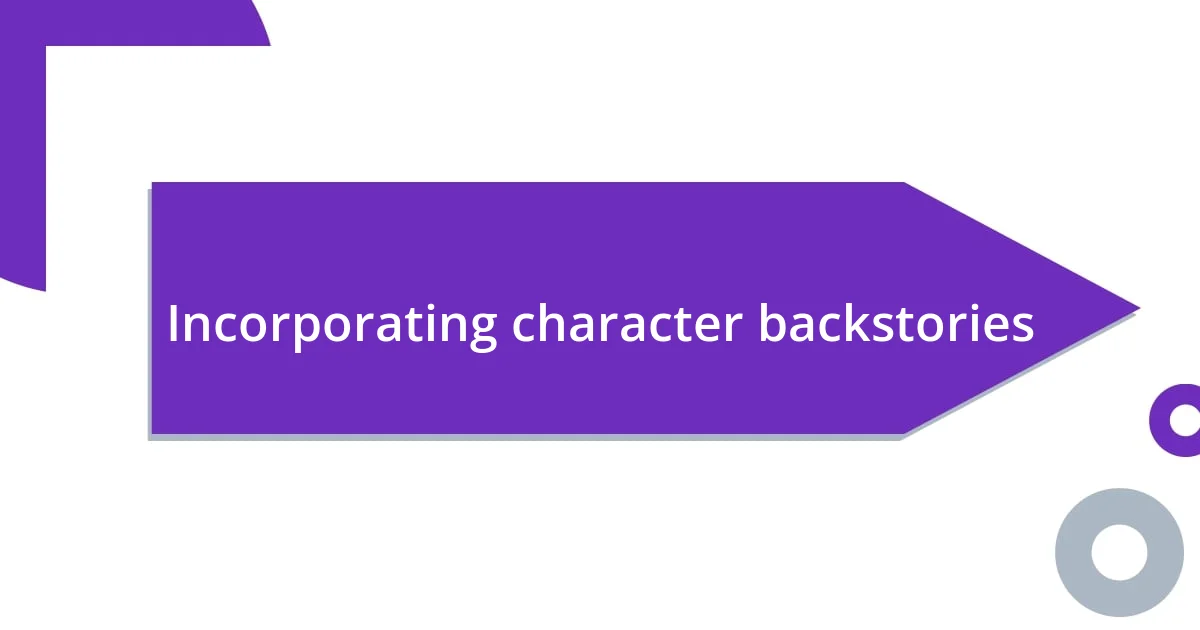Key takeaways:
- Character sketches should encapsulate physical attributes, emotional landscapes, quirks, backstories, and motivations to create relatable and multi-dimensional figures.
- Utilizing techniques such as role-playing, character questionnaires, and sensory details can enhance character development and evoke deeper reader connections.
- Analyzing a character’s backstory and motivations reveals layers of complexity, driving the narrative and fostering empathy with the audience.

Understanding character sketches
Character sketches serve as a snapshot of a person, capturing essential traits that define them. I often think of a character sketch as a window into someone’s soul, presenting not just their physical appearance but their unique quirks and motivations. When I craft a character sketch, I always ask myself, “What drives this person?” or “What do they fear the most?” These questions guide me in revealing the deeper layers of their personality.
In my experience, it’s the little details that truly bring a character to life. For instance, I once described a friend who nervously twirls a pen when deep in thought. That simple action spoke volumes about her overthinking and passion for perfection. It’s fascinating how such gestures can encapsulate emotions and experiences, forming a concrete connection with the reader.
Moreover, I find that understanding a character’s backstory adds richness to their portrayal. When I delve into their past, I can explore how their experiences shape their current choices. Isn’t it intriguing to see how a childhood event can influence someone’s adult decisions? Every character sketch I write becomes a journey into the complexities of human nature, which keeps me coming back to this art form again and again.

Key elements of character sketches
Character sketches thrive on a blend of authenticity and detail that paints a vivid picture of the subject. For me, it’s essential to capture not only the character’s attributes but also their emotional landscape. I remember sketching a character based on a mentor of mine; I described her as having a “voice that seemed to dance”—this encapsulated both her speaking style and the warmth she embodied. That interplay between description and emotion can resonate with readers on a deeper level.
Key elements of character sketches include:
- Physical Attributes: Describe what the character looks like, from hair color to style of clothing. These details help readers visualize the character.
- Emotions and Traits: Mention the character’s dominant emotions or personality traits, similar to hearing a friend’s laugh that reveals so much about their joyfulness.
- Quirks: Include unique habits or idiosyncrasies that make the character relatable, like my tendency to tap my fingers when excited.
- Backstory: Offer snippets of their past, shedding light on how experiences shaped who they are today. Think of how a careless remark in childhood can affect someone’s self-esteem all their life.
- Motivations and Fears: Dive into what drives them and what they dread most, as these inner struggles can create tension in the narrative.
By weaving these elements together, I believe a character sketch becomes not just a description but a glimpse into someone’s world, evoking empathy and connection with the reader.

Techniques for developing characters
Character development techniques often require diving deep into both the psyche and the quirks of a person. I find that role-playing the character in various scenarios can reveal unexpected traits and reactions. For instance, once I acted out a scene where my character faced a moral dilemma, and I was surprised to discover her compassionate yet conflicted nature. It’s a powerful method that can unveil inherent contradictions and enrich the character.
In addition to role-playing, I frequently create detailed character questionnaires. These questionnaires prompt introspection and can cover aspects from favorite foods to significant life events. I still remember crafting one for a character inspired by my grandmother; it helped me realize her profound sense of duty often masked her own desires. This technique not only solidifies the character’s identity but can also lead to more compelling storytelling.
Another approach I cherish is incorporating sensory details. What does the character smell in a particular moment? What sounds surround them? One time, I described a character listening to the rhythmic rain on a rooftop while feeling anxious about an upcoming decision. This technique can evoke emotions and place readers in the scene, making them feel as if they are experiencing those moments alongside the character.
| Technique | Description |
|---|---|
| Role-Playing | Acting out scenarios to explore character traits and reactions. |
| Questionnaires | Creating detailed prompts to delve deep into the character’s psyche. |
| Sensory Details | Incorporating the five senses to evoke emotions and enhance scene immersion. |

Using prompts for character sketches
Using prompts for character sketches can truly unleash creativity. When I sit down with a list of thought-provoking prompts, I often find new facets of my characters emerging. For example, one time, I used a prompt that asked me to describe my character’s worst fear. This simple question revealed layers of vulnerability I hadn’t considered, ultimately making her more relatable and relatable characters are the ones that linger in readers’ minds.
I also love prompts that focus on relationships. Imagining how my character interacts with others often leads to insightful revelations. A prompt that asked, “Who would your character call in a crisis?” led me to explore not just who she trusts, but also the cracks in her relationships. An unexpected twist! It’s fascinating to see how these connections can shape a character’s arc and give depth to their motivations.
Ultimately, I believe prompts are like keys to a treasure chest. Each time I engage with them, I unlock new possibilities for my characters. Have you ever thought about what your character would do in a mundane situation? I once explored a character in an ordinary grocery store line, where her inner thoughts revealed her anxieties. That little moment added a surprising amount of realism and depth. It’s moments like these that help me connect with my characters on a personal level.

Analyzing character motivations
When I dive into character motivations, I love to ask myself the big “why” behind their actions. For instance, I once created a character who seemed confident on the outside but was riddled with insecurities about her past. As I explored those motivations, I discovered that her drive for success stemmed from a childhood need to prove her worth. This kind of introspection can unveil layers that truly resonate with readers, connecting them to the character on a deeper level.
It’s fascinating to dissect how a character’s experiences shape their desires. I remember writing about a character whose traumatic childhood pushed her toward self-sabotage in relationships. By analyzing her motivations, I found that her fear of vulnerability made her push away those who genuinely cared. This revelation added a heartbreaking complexity to her journey, illustrating how our past can intricately weave into our present emotions and choices.
Whenever I’m refining a story, I glance back at a character’s defining moment—the one event that ignited their motivations. I once developed a character whose life changed when she lost a loved one, fueling her passion for helping others. Reflecting on these pivotal moments can drive the narrative forward, creating an authentic emotional connection. It begs the question: What moment in your character’s life truly defined them? Exploring that can breathe life into your sketches, making them feel real and relatable.

Incorporating character backstories
Incorporating a character’s backstory is essential for creating a rich, multi-dimensional figure that resonates with readers. I remember crafting a character who had grown up in a volatile household; this experience shaped not only her worldview but also her fear of intimacy. When I explored her past, I realized her hesitation to trust others stemmed from never knowing when the ground beneath her would shift. Such revelations can give readers an emotional anchor, making them more invested in the character’s journey.
I often think about how the smallest details in a character’s history can create significant ripples in their behavior. For example, I once wrote about a character who had a passion for painting due to the encouragement of a beloved grandparent. However, after that grandparent’s passing, she abandoned her easel, feeling undeserving of joy. That backstory allowed me to weave themes of loss and redemption into her arc, engaging readers who might empathize with the struggle of reconciling passion with grief. Have you considered how your character’s history could influence their present decisions?
The beauty of backstories lies in their ability to transform a character from a simple trope into a relatable individual. I once developed a minor character who appeared merely as a quirky neighbor, yet upon diving into her backstory, I discovered she had been a renowned writer in her youth. This hidden depth added layers to our interactions, revealing her wisdom while also highlighting regrets that influenced her current life. These discoveries are often where the magic happens. What unique traits might you uncover in your character’s history that could elevate their narrative?

Tips for refining character sketches
When refining character sketches, I find it incredibly helpful to visualize each character in different life situations, not just the ones that are essential to the plot. I once imagined how a typically stoic character would react at a birthday party versus a funeral. This exercise revealed nuances in their personality, illustrating how context can dramatically shift a character’s behavior and emotional responses. Have you tried placing your characters in contrasting scenarios to see their true selves emerge? This approach has often added depth to my sketches, making them feel more authentic and relatable.
In my experience, dialogue is a crucial tool for refining character sketches. An interesting exercise I enjoy is writing a series of conversations between characters without any context. This often leads me to discover their unique voice and quirks, helping me understand their relationships with others. The way they speak can reveal insecurities, humor, or even hidden resentments. Have you observed how a character’s choice of words can unravel layers of their personality? Engaging in this way not only enhances their individuality but also enriches the narrative overall.
Lastly, I believe that emotion is at the heart of every compelling character. I once developed a character whose relentless pursuit of perfection was rooted in deep-seated feelings of inadequacy. By delving into her emotional struggles, I was able to craft moments that truly resonated with readers, illustrating how her fear of failure guided her decisions. It’s essential to ask yourself: What fears or desires drive your characters’ actions? Tapping into those raw emotions can elevate your sketches, making them leap off the page and connect with readers on a profound level.














